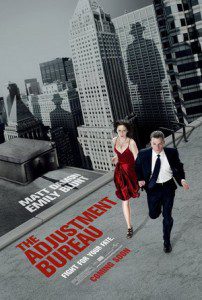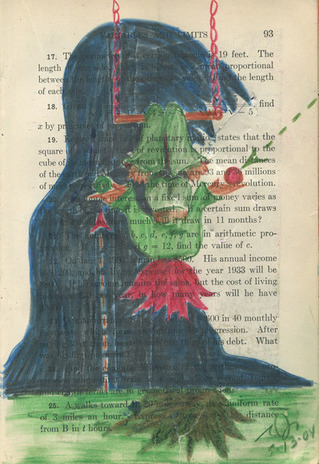 I like the doors in “The Adjustment Bureau”, the latest movie based on a story by the scifi great Philip K. Dick. They are by far the best way to get across mid-town. Turn the handle, and you might step from an apartment into a stadium, and from there into City Hall. As long as you are wearing the right hat.
I like the doors in “The Adjustment Bureau”, the latest movie based on a story by the scifi great Philip K. Dick. They are by far the best way to get across mid-town. Turn the handle, and you might step from an apartment into a stadium, and from there into City Hall. As long as you are wearing the right hat.
The Men in Hats are the adjusters, who work behind the scenes to enforce a plan for every life. Get off plan, and you are likely to find your future is adjusted – though you aren’t supposed to know this is going on.
The film is a think-piece about free will versus determinism, one of the perennial themes, that is so packed with action and romance that it’s far from a head-trip. Nonetheless, it will make you think about those odd incidents in a day that may have thrown you from one event track on to another. If the adjuster hadn’t fallen asleep on a park bench and had carried out his orders to spill coffee on the Matt Damon character’s shirt before 7:05 AM, forcing him to go home and change before a meeting, then Matt wouldn’t have met the girl again by “chance” on the bus….and so on.
–
I hope it’s not a spoiler to say that love conquers all in a feel-good ending, made plausible by the sizzling on-screen chemistry between Matt Damon and Emily Blunt. A happy ending is just fine with me, though I was hoping for a glimpse of the unseen, undefined Chairman who is behind the adjusters, the one who lays down the plans for human lives that they enforce. I gather the movie-makers considered an alternate ending in which the Chairman (God? a lesser Demiurge?) makes a cameo appearance – as a woman.
It’s a savage irony that Philip K. Dick (hereafter PKD), whose work was mostly confined to the pulp magazines in his lifetime, has been the inspiration for a whole slew of big-budget and generally superior movies since his death in 1982. The first film based on his work that grabbed the popular imagination was “Bladerunner”. The subsequent list includes “Total Recall”, “Minority Report” (my personal favorite) and “A Scanner Darkly”.
–
PKD’ was an American original, a brilliant mind often at the edge of madness, a traveler in the multiverse forever probing the big questions. What is reality? When are we real? How can we tell if we are dreaming? Is there meaning to our lives? Do we have choice?
His fiction is filled with eroding universes, with reality constructs that are coming apart. He returned again and again to the idea that in our regular lives, reality is veiled: the big stuff is hidden from us behind a veil. What will we find if we push behind the curtain? Maybe we’ll find that in waking life we are actually dead, living in a Purgatory from which we’ll only be allowed to graduate when we have passed the tests. Maybe we’ll discover that we are living in one of countless parallel worlds, constantly moving back and forth between them though we don’t notice this because individual and collective memories are adjusted every time we make a switch. Maybe we’ll find the Nazis won World War II, or the Roman Empire never ended. Maybe we’ll learn, like the Matt Damon character, that the choices we thought we were making are actually directed by the Men in Hats.
–
I’ve now watched “Minority Report” four times, and will probably watch it again.It was inspired by a story PKD first published in a pulp magazine back in 1954.
–
The story plot is notably different from that of the film, and the depiction of the precogs – not drifting in a flotation tank here, simply wired up to a mass of machinery that spits out cards rather than balls – is savagely harsh; they are called “babbling idiots” and “monkeys” who suffer from brain deformations that enable them to pump out information about future events they could never begin to understand.
–
Try reading he original version of “The Minority Report” for a provocative introduction to the nature of multiple or probable futures. As PKD writes: “If only one time-path existed, precognitive information would be of no importance, since no possibility would exist, in possessing this information, of altering the future.” Exactly. To see something is already to change it, though we should not leap to the conclusion (expressed by a villain in the story) that “as soon as precognitive information is obtained, it cancels itself out.”
In the story collection in which “The Minority Report” is included, the editor has included a welcome quote from a 1974 interview with PKD
–
I used to believe the universe was basically hostile…I had a lot of fears that the universe would discover just how different I was from it…that it would find out the truth about me, and its reaction would be perfectly normal: it would get me. I didn’t feel that it was malevolent, just perceptive…But this year I realized that that’s not true. That the universe is perceptive, but it’s friendly.
I’m glad PKD evolved this view. If we are going to harbor a conspiracy theory about the universe, let’s infuse it with pronoia (the wild belief that the universe is benign and things will work out for the best, regardless of evidence) rather than paranoia. Maybe PKD would even have approved the sappy but heart-warming finale of “The Adjustment Bureau”. Who knows? Maybe, like one of his Men in Hats, he helped to adjust the scripting.

